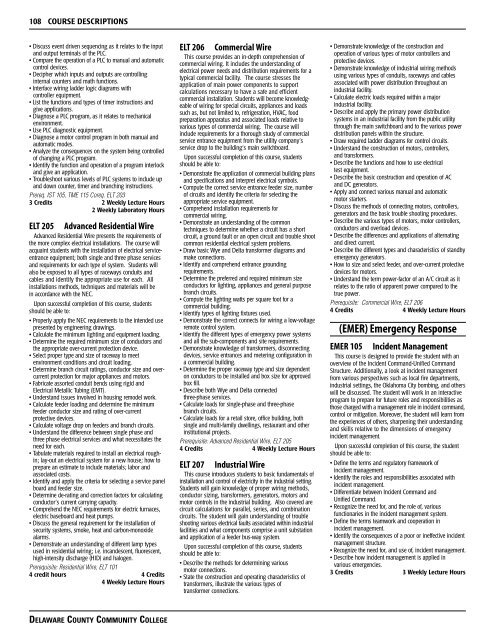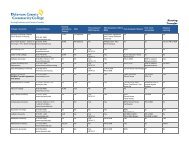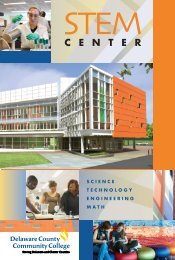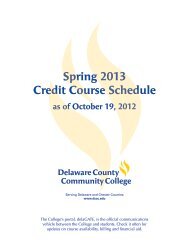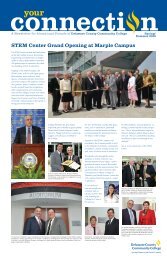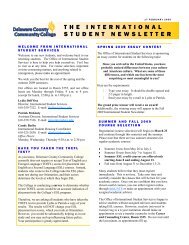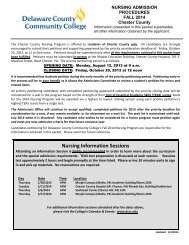2010 Catalog - Delaware County Community College
2010 Catalog - Delaware County Community College
2010 Catalog - Delaware County Community College
Create successful ePaper yourself
Turn your PDF publications into a flip-book with our unique Google optimized e-Paper software.
108 COURSE DESCRIPTIONS<br />
• Discuss event driven sequencing as it relates to the input<br />
and output terminals of the PLC.<br />
• Compare the operation of a PLC to manual and automatic<br />
control devices.<br />
• Decipher which inputs and outputs are controlling<br />
internal counters and math functions.<br />
• Interface wiring ladder logic diagrams with<br />
controller equipment.<br />
• List the functions and types of timer instructions and<br />
give applications.<br />
• Diagnose a PLC program, as it relates to mechanical<br />
environment.<br />
• Use PLC diagnostic equipment.<br />
• Diagnose a motor control program in both manual and<br />
automatic modes.<br />
• Analyze the consequences on the system being controlled<br />
of changing a PLC program.<br />
• Identify the function and operation of a program interlock<br />
and give an application.<br />
• Troubleshoot various levels of PLC systems to include up<br />
and down counter, timer and branching instructions.<br />
Prereq. IST 105, TME 115 Coreq. ELT 203<br />
3 Credits 2 Weekly Lecture Hours<br />
2 Weekly Laboratory Hours<br />
ELT 205<br />
Advanced Residential Wire<br />
Advanced Residential Wire presents the requirements of<br />
the more complex electrical installations. The course will<br />
acquaint students with the installation of electrical serviceentrance<br />
equipment; both single and three phase services<br />
and requirements for each type of system. Students will<br />
also be exposed to all types of raceways conduits and<br />
cables and identify the appropriate use for each. All<br />
installations methods, techniques and materials will be<br />
in accordance with the NEC.<br />
Upon successful completion of this course, students<br />
should be able to:<br />
• Properly apply the NEC requirements to the intended use<br />
presented by engineering drawings.<br />
• Calculate the minimum lighting and equipment loading.<br />
• Determine the required minimum size of conductors and<br />
the appropriate over-current protection device.<br />
• Select proper type and size of raceway to meet<br />
environment conditions and circuit loading.<br />
• Determine branch circuit ratings, conductor size and overcurrent<br />
protection for major appliances and motors.<br />
• Fabricate assorted conduit bends using rigid and<br />
Electrical Metallic Tubing (EMT).<br />
• Understand issues involved in housing remodel work.<br />
• Calculate feeder loading and determine the minimum<br />
feeder conductor size and rating of over-current<br />
protective devices.<br />
• Calculate voltage drop on feeders and branch circuits.<br />
• Understand the difference between single phase and<br />
three phase electrical services and what necessitates the<br />
need for each.<br />
• Tabulate materials required to install an electrical roughin;<br />
lay-out an electrical system for a new house; how to<br />
prepare an estimate to include materials; labor and<br />
associated costs.<br />
• Identify and apply the criteria for selecting a service panel<br />
board and feeder size.<br />
• Determine de-rating and correction factors for calculating<br />
conductor’s current carrying capacity.<br />
• Comprehend the NEC requirements for electric furnaces,<br />
electric baseboard and heat pumps.<br />
• Discuss the general requirement for the installation of<br />
security systems, smoke, heat and carbon-monoxide<br />
alarms.<br />
• Demonstrate an understanding of different lamp types<br />
used in residential wiring; i.e. incandescent, fluorescent,<br />
high-intensity discharge (HID) and halogen.<br />
Prerequisite: Residential Wire, ELT 101<br />
4 credit hours 4 Credits<br />
4 Weekly Lecture Hours<br />
ELT 206<br />
Commercial Wire<br />
This course provides an in-depth comprehension of<br />
commercial wiring. It includes the understanding of<br />
electrical power needs and distribution requirements for a<br />
typical commercial facility. The course stresses the<br />
application of main power components to support<br />
calculations necessary to have a safe and efficient<br />
commercial installation. Students will become knowledgeable<br />
of wiring for special circuits, appliances and loads<br />
such as, but not limited to, refrigeration, HVAC, food<br />
preparation apparatus and associated loads relative to<br />
various types of commercial wiring. The course will<br />
include requirements for a thorough study of commercial<br />
service entrance equipment from the utility company’s<br />
service drop to the building’s main switchboard.<br />
Upon successful completion of this course, students<br />
should be able to:<br />
• Demonstrate the application of commercial building plans<br />
and specifications and interpret electrical symbols.<br />
• Compute the correct service entrance feeder size, number<br />
of circuits and identify the criteria for selecting the<br />
appropriate service equipment.<br />
• Comprehend installation requirements for<br />
commercial wiring.<br />
• Demonstrate an understanding of the common<br />
techniques to determine whether a circuit has a short<br />
circuit, a ground fault or an open circuit and trouble shoot<br />
common residential electrical system problems.<br />
• Draw basic Wye and Delta transformer diagrams and<br />
make connections.<br />
• Identify and comprehend entrance grounding<br />
requirements.<br />
• Determine the preferred and required minimum size<br />
conductors for lighting, appliances and general purpose<br />
branch circuits.<br />
• Compute the lighting watts per square foot for a<br />
commercial building.<br />
• Identify types of lighting fixtures used.<br />
• Demonstrate the correct connects for wiring a low-voltage<br />
remote control system.<br />
• Identify the different types of emergency power systems<br />
and all the sub-components and site requirements.<br />
• Demonstrate knowledge of transformers, disconnecting<br />
devices, service entrances and metering configuration in<br />
a commercial building.<br />
• Determine the proper raceway type and size dependent<br />
on conductors to be installed and box size for approved<br />
box fill.<br />
• Describe both Wye and Delta connected<br />
three-phase services.<br />
• Calculate loads for single-phase and three-phase<br />
branch circuits.<br />
• Calculate loads for a retail store, office building, both<br />
single and multi-family dwellings, restaurant and other<br />
institutional projects.<br />
Prerequisite: Advanced Residential Wire, ELT 205<br />
4 Credits 4 Weekly Lecture Hours<br />
ELT 207<br />
Industrial Wire<br />
This course introduces students to basic fundamentals of<br />
installation and control of electricity in the industrial setting.<br />
Students will gain knowledge of proper wiring methods,<br />
conductor sizing, transformers, generators, motors and<br />
motor controls in the industrial building. Also covered are<br />
circuit calculations for parallel, series, and combination<br />
circuits. The student will gain understanding of trouble<br />
shooting various electrical faults associated within industrial<br />
facilities and what components comprise a unit substation<br />
and application of a feeder bus-way system.<br />
Upon successful completion of this course, students<br />
should be able to:<br />
• Describe the methods for determining various<br />
motor connections.<br />
• State the construction and operating characteristics of<br />
transformers, illustrate the various types of<br />
transformer connections.<br />
• Demonstrate knowledge of the construction and<br />
operation of various types of motor controllers and<br />
protective devices.<br />
• Demonstrate knowledge of industrial wiring methods<br />
using various types of conduits, raceways and cables<br />
associated with power distribution throughout an<br />
industrial facility.<br />
• Calculate electric loads required within a major<br />
industrial facility.<br />
• Describe and apply the primary power distribution<br />
systems in an industrial facility from the public utility<br />
through the main switchboard and to the various power<br />
distribution panels within the structure.<br />
• Draw required ladder diagrams for control circuits.<br />
• Understand the construction of motors, controllers,<br />
and transformers.<br />
• Describe the functions and how to use electrical<br />
test equipment.<br />
• Describe the basic construction and operation of AC<br />
and DC generators.<br />
• Apply and connect various manual and automatic<br />
motor starters.<br />
• Discuss the methods of connecting motors, controllers,<br />
generators and the basic trouble shooting procedures.<br />
• Describe the various types of motors, motor controllers,<br />
conductors and overload devices.<br />
• Describe the differences and applications of alternating<br />
and direct current.<br />
• Describe the different types and characteristics of standby<br />
emergency generators.<br />
• How to size and select feeder, and over-current protective<br />
devices for motors.<br />
• Understand the term power-factor of an A/C circuit as it<br />
relates to the ratio of apparent power compared to the<br />
true power.<br />
Prerequisite: Commercial Wire, ELT 206<br />
4 Credits 4 Weekly Lecture Hours<br />
(EMER) Emergency Response<br />
EMER 105<br />
Incident Management<br />
This course is designed to provide the student with an<br />
overview of the Incident Command-Unified Command<br />
Structure. Additionally, a look at incident management<br />
from various perspectives such as local fire departments,<br />
industrial settings, the Oklahoma City bombing, and others<br />
will be discussed. The student will work in an interactive<br />
program to prepare for future roles and responsibilities as<br />
those charged with a management role in incident command,<br />
control or mitigation. Moreover, the student will learn from<br />
the experiences of others, sharpening their understanding<br />
and skills relative to the dimensions of emergency<br />
incident management.<br />
Upon successful completion of this course, the student<br />
should be able to:<br />
• Define the terms and regulatory framework of<br />
incident management.<br />
• Identify the roles and responsibilities associated with<br />
incident management.<br />
• Differentiate between Incident Command and<br />
Unified Command.<br />
• Recognize the need for, and the role of, various<br />
functionaries in the incident management system.<br />
• Define the terms teamwork and cooperation in<br />
incident management.<br />
• Identify the consequences of a poor or ineffective incident<br />
management structure.<br />
• Recognize the need for, and use of, incident management.<br />
• Describe how incident management is applied in<br />
various emergencies.<br />
3 Credits 3 Weekly Lecture Hours<br />
DELAWARE COUNTY COMMUNITY COLLEGE


